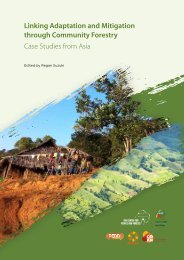Desktop Study on - Regional Climate Change Adaptation ...
Desktop Study on - Regional Climate Change Adaptation ...
Desktop Study on - Regional Climate Change Adaptation ...
You also want an ePaper? Increase the reach of your titles
YUMPU automatically turns print PDFs into web optimized ePapers that Google loves.
Assessment of Capacity Gaps and Needs of South East Asia Countries<br />
in Addressing Impacts, Vulnerability and Adaptati<strong>on</strong> to <strong>Climate</strong> Variability and <strong>Climate</strong> <strong>Change</strong><br />
land erosi<strong>on</strong>. Additi<strong>on</strong>ally, water resources appear<br />
to be degrading and suffering negative impacts<br />
from deforestati<strong>on</strong> and polluti<strong>on</strong> (Trung, unknown).<br />
Also, the most populated areas and where the main<br />
ec<strong>on</strong>omic activity is taking place are those with high<br />
flood risks, increased salinity of water resources and<br />
other hazards related to water resources.<br />
The Initial Nati<strong>on</strong>al Communicati<strong>on</strong> lists suggestive<br />
measures for adaptati<strong>on</strong> to climate change impacts<br />
(MoNRE, 2003):<br />
Building reservoirs with the total additi<strong>on</strong>al<br />
capacity of 15 - 20 billi<strong>on</strong> m3 for c<strong>on</strong>taining<br />
flood water to mitigate losses caused by floods,<br />
and to regulate water during low-flow seas<strong>on</strong>.<br />
High priority should be given to the eastern<br />
parts of South Viet Nam, central highland and<br />
mountainous areas in North Viet Nam;<br />
Upgrading and raising the scale of drainage<br />
systems, the existing sea and river-mouth<br />
dykes, and building new sea dykes;<br />
C<strong>on</strong>trolling populati<strong>on</strong> growth rate in vulnerable<br />
areas and organizing new resettlement areas to<br />
avoid the effects of sea level rise;<br />
Reclaiming areas, especially in hilly midland<br />
areas in the North Viet Nam, for agricultural<br />
producti<strong>on</strong>;<br />
Use of water effectively with special attenti<strong>on</strong><br />
to increased run-offs during low- flow seas<strong>on</strong>,<br />
which is regulated by reservoirs upstream;<br />
Sustainable use of water sources;<br />
C<strong>on</strong>ducting studies in l<strong>on</strong>g-term water<br />
resources predicti<strong>on</strong>, seas<strong>on</strong>al, inter-annual<br />
predicti<strong>on</strong>s of water sources for planning<br />
rati<strong>on</strong>al and safe use of surface water sources.<br />
The MRC <strong>on</strong> its <strong>Climate</strong> <strong>Change</strong> Adaptati<strong>on</strong> in the<br />
Lower Mek<strong>on</strong>g Basin Countries Report lists <strong>on</strong>going<br />
activities, such as : upgrading and raising the level of<br />
drainage system; limiting populati<strong>on</strong> growth rate and<br />
redistributi<strong>on</strong> of residential areas; cooperati<strong>on</strong> for<br />
efficient water use; c<strong>on</strong>ducting studies in l<strong>on</strong>g‐term<br />
water resources predicti<strong>on</strong>; and implementati<strong>on</strong> of<br />
the strategy “Living with Flood”.<br />
Other adaptati<strong>on</strong> activities are being implemented<br />
as part of the Nati<strong>on</strong>al Strategy and Acti<strong>on</strong> Plan<br />
for Disaster Mitigati<strong>on</strong> and Management in Viet<br />
Nam 2001‐2020 and the MRC Strategy <strong>on</strong> Flood<br />
Management and Mitigati<strong>on</strong>. The Nati<strong>on</strong>al Strategy<br />
stresses the noti<strong>on</strong> of living with the floods. This<br />
includes various fixed requirements for flood<br />
safety and security in residential areas. Also, there<br />
is a program for house foundati<strong>on</strong>s to make them<br />
more flood secure. Low‐level dyke systems already<br />
c<strong>on</strong>trol saltwater intrusi<strong>on</strong> and early flooding, and<br />
water management in the Mek<strong>on</strong>g Delta, focusing<br />
<strong>on</strong> irrigati<strong>on</strong> water supply and preventi<strong>on</strong> of saline<br />
water intrusi<strong>on</strong> (ICEM, 2009). Thus, in the northern<br />
regi<strong>on</strong>, the emphasis is more <strong>on</strong> ‘positively prepare<br />
for and prevent flood’, and in the central part,<br />
it is <strong>on</strong> ‘positive preparedness, mitigati<strong>on</strong>, and<br />
management’.<br />
Gaps Identified in Programs and<br />
Studies<br />
Currently there are policies, laws, programs and<br />
projects related with water resources protecti<strong>on</strong>, but<br />
there are still some weaknesses in water resources<br />
management. This could be summarized as the need<br />
of a l<strong>on</strong>g-term strategies <strong>on</strong> nati<strong>on</strong>al and regi<strong>on</strong>al<br />
scales; that water resources have not been managed<br />
according to basin system; that the provisi<strong>on</strong> <strong>on</strong> the<br />
protecti<strong>on</strong>, utilizati<strong>on</strong> and management of water<br />
resources have been insufficient, including suitable<br />
management instruments <strong>on</strong> water quality standards<br />
and the limits for underground water utilizati<strong>on</strong> for<br />
each regi<strong>on</strong>; and finally, low investment for irrigati<strong>on</strong><br />
works having imperfect works as a result.<br />
Recent Projects in the Water Sector<br />
The Institute for Envir<strong>on</strong>mental Studies, ACACIA<br />
Water started the ADAPTS project, undertaking the<br />
Adaptive Water Management at the Local Scale – a<br />
Viet Nam case study in 2008. The overall aim of<br />
ADAPTS is to increase developing countries’ adaptive<br />
capacities by achieving the inclusi<strong>on</strong> of climate<br />
change and adaptati<strong>on</strong> c<strong>on</strong>siderati<strong>on</strong>s in water<br />
policies, local planning and investment decisi<strong>on</strong>s (My<br />
et al., 2008). The project is being implemented in six<br />
river basins around the world; and in Viet Nam, it is<br />
the Hu<strong>on</strong>g River Basin. Around 800,000 people live in<br />
the Hu<strong>on</strong>g River Basin. Their livelihoods, small-scale<br />
agriculture and fisheries, depend <strong>on</strong> the river and the<br />
lago<strong>on</strong> into which the river drains. The local partner<br />
Centre for Social Research and Development (CSRD)<br />
aims to take climate change and adaptati<strong>on</strong> into<br />
account in their work and support local adaptati<strong>on</strong><br />
measures. CSRD also aims to facilitate dialogue<br />
between communities, researchers and government<br />
authorities <strong>on</strong> climate change and adaptati<strong>on</strong> in the<br />
basin, and supports the establishment of a platform<br />
<strong>on</strong> <strong>Climate</strong> <strong>Change</strong> in Central Viet Nam.<br />
According to the matrix of climate change activities<br />
elaborated by the World Bank in collaborati<strong>on</strong> with<br />
the Government of Viet Nam, d<strong>on</strong>ors and NGOs<br />
(World Bank, 2009b), here are some of the projects<br />
identified under the water sector: (i) Impact of<br />
37

















